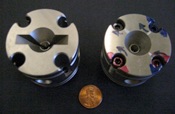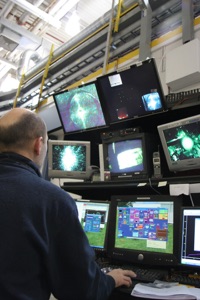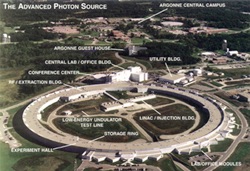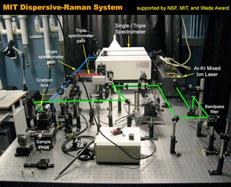The Lab for Earth and Planetary Materials hosts analytical instruments and high-pressure devices which enable researchers to study the (1) properties, (2) chemical reactions, (3) phase transitions, and (4) atomic-scale structures of Earth and planetary materials, such as silicates, oxides, iron alloys, icy materials, and amorphous phases at the pressure and temperature conditions of Earth and planetary interiors.
Diamond-anvil cells
Diamond-anvil cells can generate very high pressures (1-10
6 bars) by compressi
ng materials between two gem-quality diamond anvils. Diamond is the strongest among known materials and is transparent to a wide range of electromagnetic radiations, such as X-rays, infrared, and visible light. These properties enable us to carry out in situ diffraction or spectroscopy measurements at extreme pressure-temperature conditions. Several different types of the diamond-anvil cells are available in our lab.
Samples in the diamond-anvil cells can be heated over 5,000 K using laser heating technique. Temperature can be estimated by fitting thermal radiation spectrum from the sample to the Planck's black body equation. Our laser heating system consists of a Nd:YLF laser (1053 nm, 45 W, diode-pump), an imaging spectrometer, a Peltier cooled CCD detector, and other optical components.
X-ray diffraction and spectroscopy
Recent developments
at synchrotron facilities (e.g.,
Advanced Photon Source,
National Synchrotron Light Source,
Advanced Light Source,
and
Stanford Synchrotron Radiation Laboratory) have enabled us to perform measurements directly at high pressure and high temperature. Synchrotron radiation provides extremely bright X-ray beams for diffraction and spectroscopy. Diffraction using highly collimated intense synchrotron X-ray beams and two dimensional detectors opens new opportunities to study (1) multi-phase systems, (2) material strength at high pressure and temperature, (3) phase diagrams, and (4) equations of state of materials. X-ray spectroscopy techniques also are available for high-pressure research and enable to measure many important physical properties of materials, such as valence and spin states of iron in planetary materials, and velocity of materials.
Raman spectroscopy
Our Raman spectroscopy systems are designed to study (1) thermodynamic properties and (2) phase transitions
of materials at a wide range of pressures and temperatures. Raman spectroscopy is a complementary tool to the X-ray diffraction to study crystal structures. Raman spectroscopy is particularly powerful to study planetary icy materials (e.g., H
2O, NH
3, CH
4, and CO
2).
Two different Raman systems are available in our lab: (1) a dispersive Raman system and (2) a nanosecond gated Raman system.
The dispersive Raman system consists of an Ar/Kr-mixed-ion laser, a triple spectrometer, and other optical components. The Ar/Kr-ion laser provides Raman excitation source with a wide range of wavelengths from 458 to 753 nm. Short
wavelength laser lines are useful for measurements up to ~1,000 K because they shift Raman spectral range to lower wavelengths where thermal radiation is still low. Long wavelength laser lines can be used for highly fluorescent materials as they excite less fluorescence. The triple spectrometer provides extremely high resolution. For weak Raman scattering, a single spectrometer in the triple spectrometer can be used for high throughput measurements combined with a notch filter. Tight laser beam focus (1-2 microns) with a confocal setup achieves high spatial and depth resolution [see Shim et al, 2007, EPSL,
PDF; Shim and Catalli, 2009, EPSL,
PDF for example spectra].
The nano-second gated Raman system effectively reduces the detection of intense thermal radiation from samples at high temperatures (> 1,200 K). It consists of a
frequency-doubled Nd:YLF laser (527 nm, 0.1-10 kHz rep rate, 20 ns pulse width), an intensified gated CCD detector (>20 ns gate width), and other optical components. This system enhances the signal-to-background ratio by more than four orders of magnitude at high temperature [see Slotznick and Shim, 2008, American Mineralogist,
PDF; Zucker and Shim, 2009, American Mineralogist,
PDF].
Both dispersive and gated Raman systems can also be used for ruby pressure estimation. Combined with a micro-heater, the nanosecond gated spectroscopy system can study the optical properties of solids and melts at high temperatures up to 1,800 K at 1 bar.
Other instruments
Several instruments for sample preparation are available: (1) micro-drill systems (mechanical and EDM) to produce small gasket holes (20-300 microns in diameter), (2) two high-resolution stereomicroscopes, (3) two cryogenic gas loading systems, (4) a micro heating stage (Linkam), and (5) ring heaters to heat samples in the diamond-anvil cell up to 1,200 K.
Other related facilities at ASU
Multi-anvil press at department of chemistry
Electron microscopes and FIB/SEM at LeRoy Eyring Center for Solid State Science
NanoSIMS and SIMS at The Secondary Ion Mass Spectrometry Labs
Electron microprobe at CLAS Electron Microprobe Facility
The construction of the dispersive Raman scattering, gated Raman scattering, and laser heating systems is supported by the National Science Foundation (Earth Science Infrastructure program), and Wade fund.








